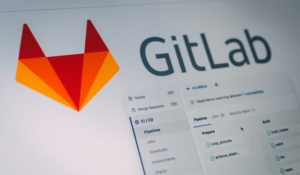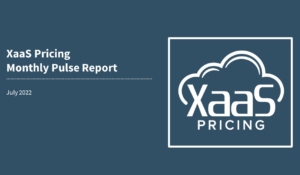Internet time traveling — and what it means for SaaS pricing
Time travel is a common plot device for action movies and comedies. The Back to the Future series is probably the best known in the category, and certainly my personal favorite. The basic premise of these types of movies is usually the same: The protagonists need to travel back in time to alter something about the past to ensure there is no future negative impact to their lives or the world. For Marty McFly, this amounted to making sure that his parents got together back in 1955 so he could preserve his own life in the future.
In real life, time travel is the stuff of futurists and internet mystery explorers. On this latter piece, far-fetched as it may be, I must admit that some of the supposed time-travel photos out there are pretty compelling. True or not, it’s a fun rabbit hole to dive down. But there’s one place where you can absolutely, without question, time travel: the internet.
We’ve mentioned before our affection for the Wayback Machine as a tool for research, but it bears repeating here. The Wayback Machine allows you, with the click of a button, to go back in time and look at any of over 700 billion archived webpages that the site has cataloged.
So, what does this mean for SaaS pricing? If you’re interested in how the pricing strategy and the positioning of pricing have evolved over time for a given company that you are emulating or competing with, the Wayback Machine is the tool for you. By assessing changes in pricing and positioning over time, you can diagnose how the company’s value proposition has evolved and how the company has aimed to articulate and capture that value through its pricing. If you’re a founder or early-stage company, this type of analysis can help you realize that “everyone has to start somewhere” and that pricing, even for the best, largest and fastest-growing companies, is never finished.
Breaking down the world’s first SaaS pricing page
Salesforce is generally considered to be the first SaaS company. It stands to reason, then, that Salesforce would be the place to look on the Wayback Machine for the world’s first SaaS pricing page — or at least the earliest one that was recorded and archived by the site.
So that’s what we did. The earliest Salesforce pricing page the site cataloged was from February 2007, and Salesforce launched in 1999, so there is a bit of a gap, but it stands to reason that this is nonetheless one of the internet’s earliest pricing pages. You can check it out for yourself here.
We ran a comparison of this page against Salesforce’s current pricing page to see what’s changed and what hasn’t. Here are our findings:
- Page design for websites sure has come a long way. This one really brings me back to the dial-up internet days. But we largely have to throw out page design from the comparison. Salesforce was using the tools it had at its disposal.
- With the exception of the Essentials edition, plan names have stayed the same. Salesforce’s core packaging, which includes four to five editions, has remained intact since launch. The bones of the Professional, Enterprise and Unlimited editions have been in place for 15-plus years.
- Salesforce has not wavered from requiring an annual term. Annual term pricing applied in 2007, and the same model is used today.
- Salesforce used to use a “starting at” price. The site quotes a starting price of “$695 per year for a team of five users,” which equates to about $12 per user per month, and “advanced solutions starting as low as $65 per user per month.” The current pricing of Salesforce Essentials as of this writing is $25 per user per month, and the Professional edition starts at $75 per user per month. List pricing has incrementally increased over time but has not transformed dramatically.
- Salesforce got us hooked on feature tables. One of the primary calls to action (CTAs) on this site is to view a detailed features comparison of the available plans. This feature table looks extremely similar to those used across most SaaS pricing pages today. Salesforce truly started it all.
- Tiering strategies haven’t changed much. Salesforce launched early on with a tiered packaging strategy where tiers are defined based on a combination of features and usage limits. The pricing model is per user. This creates a dual flywheel model in which customers are prompted to upgrade for more users and/or for more usage. Salesforce usage metrics back in 2007 included storage per user, custom tabs, custom objects, fields per custom object, and custom applications. This dual flywheel model, with usage-based tiers and user-based pricing, is the predominant model we see used by high-growth B2B SaaS companies with product-led growth models. Growth strategies for pricing, it appears, haven’t changed much.
- Pricing page structures used to be … better? Retro design flourishes aside, the functional structure of the 2007 pricing structure works well, perhaps better than most do today. The main pricing page provides a narrative description of each plan. The narratives could be tightened to focus on value and audience, but the overall goal is to articulate the value of each plan before driving the user into a more detailed features comparison, which is available at a separate link. When we review pricing pages for our clients, we often find that this type of narrative content that is focused on value, outcomes and target customers is missing from pricing pages.
- Consider add-ons. Salesforce’s 2007 plans have over 20 features marked as requiring an additional fee. While many of those features have spun out into products of their own, there is advice here for earlier-stage companies: Consider offering add-ons that address common areas of interest for customers. Better yet, separate out features that are underutilized into add-ons, and monetize them separately for customers who really want them. This can provide a route to monetization beyond core plans.
- Calls to action are the same. Salesforce’s primary call to action in 2007 was a 30-day free trial. That remains the primary CTA used for Sales Cloud customers today.
- Salesforce’s late-stage expansion was driven by a multiproduct strategy. Not exactly an earth-shattering statement, but this analysis makes clear that there haven’t really been many material changes in packaging and pricing for Salesforce Sales Cloud since 2007. The pricing has incrementally changed, but the core pricing model, metering terms and packaging have stayed largely the same. Growth has been driven by expansion geographically as well as through development and acquisition of a suite of complementary products.
Altogether, this analysis reveals just how little Salesforce’s Sales Cloud pricing strategy has evolved over time. The core tenets have remained in place since launch, and Salesforce has focused on annual recurring revenue (ARR) expansion per customer by cross-selling and upselling add-ons and complementary products. User expansion and upgrades occur naturally with growth based on the company’s dual flywheel model for pricing and packaging.
Putting the Wayback Machine into action
Let’s take the Salesforce example with a grain of a salt. It may or may not be interesting as a specific case study for your business. Perhaps Salesforce isn’t relevant to your category. Perhaps you’re saying, “We already knew all this about Salesforce. They’re the dinosaur. That’s why HubSpot and a thousand others in the marketing technology space have been able to emerge in this space.”
That’s all beside the point. Salesforce is just an interesting example because it has a really old pricing page. But the tenets of this historical analysis can apply to any company in any sector. The key is making the historical data actionable in a future-looking context.
Here are our recommendations on how to design an effective historical pricing analysis using the Wayback Machine as a resource:
- Determine your Doc Brown(s). More Back to the Future references! Start by figuring out which organizational functions and team members will own this type of analysis and which team members will use the results. If you have dedicated competitive and market intelligence team members, that’s likely a good place to start. If there are pricing team members within competitive intelligence or a pricing strategy team that reports to a common function leader (such as marketing), they should be involved too. If pricing is a separate entity, consider a multifunctional team of competitive intelligence and pricing team members.
- Determine your goals for the analysis. At the highest level, ensure you are looking back only so you can move forward. Looking back for the sake of it is purely nostalgia. That might be fun in the moment, but it doesn’t move the needle on your business. With historical analysis, you’re searching for trending behaviors that can indicate where your competitors or peers might go next so that you can determine where you might go with your pricing strategy in response. With that mindset, ensure you have clear goals for the analysis. Is it to optimize your packaging? Assess the shift in price points over time? How will you use that information? The only wrong answer is not having one. We generally find the Wayback Machine most actionable for tracking big picture items, such as a vendor’s shift in price positioning or packaging over time.
- Translate those goals into a taxonomy. Once you’ve established your goals, create a reusable framework for capturing, indexing and analyzing the information you require. It’s fun and valuable to look at the visuals of the pricing pages over time in the Wayback Machine. But it’s more actionable to collect and index the data from the site so that it can be used for analysis. For example, if your goal is to track a competitor’s packaging model over time, you’d want to start by determining what elements of packaging you want to track. This could include things like whether they package with tiers or with another strategy; how many tiers they have; whether they define tiers by features, usage or both; and how many features and usage factors on average define each tier. When you collect the data, it’s aligned to this framework, and you can use it to identify trends and commonalities over time, and even apply the same model to other vendors that you’re interested in tracking.
- Define outcomes and deliverables. Establishing clear goals, and then translating those goals into a well-designed analytical taxonomy, will inherently help you define clear outcomes and deliverables. This taxonomy framework outlines exactly the data you’ll collect. The big items to then figure out are how you’ll analyze and present that data and, more importantly, the audience that will consume the data and insights you generate. In most cases, this type of analysis likely already fits into a working cadence that your audience has, with expectations pre-set around appropriate deliverables. Wayback Machine analysis may be infused into sales battle cards or uploaded into Klue or Crayon if your audience is sellers, or integrated into annual or quarterly pricing strategy sprints if you’re serving your pricing team.
- Don’t overdo it. The Salesforce pricing page we analyzed for this post had hundreds of screenshots in the Wayback Machine. Index everything from the site for a given competitor, and you’re probably overanalyzing. Figure out an appropriate “minimum” viable data set that you need to cull from the Wayback Machine for the purposes of the analysis you are building. For most companies, going back five years and grabbing annual, semiannual or quarterly data is likely enough. It ultimately depends on the outcomes you’re looking to deliver via the analysis.
- Go backward so you can go forward. One of the nice things about doing this type of analysis with the Wayback Machine is that you can do it once and then you’re done. The past doesn’t change, unless you’re Doc Brown and Marty McFly and can head back in your DeLorean and change it directly. Even better is that you can use this type of analysis as a springboard to a forward-looking approach. There are many SaaS tools (Visualping is one example) that can be programmed to send you alerts when a webpage changes. These tools can be instrumented for competitive price pages. If you’ve created a framework and collected historical data through the Wayback Machine, you can then use Visualping or similar tools to capture the same data against the same framework in real time going forward. You can then combine your historical and current data for a holistic prescriptive and predictive analysis. Perhaps you can even use Zapier or similar software to automate the ingestion of the Visualping data into your analytical framework.
- Look for the “why,” not just the “what.” Capturing the Wayback Machine data is half the battle. But the data itself doesn’t outwardly reveal the motivations or strategies that inspired the changes a competitor made. This is where the analysis part comes in. Often, the qualitative content of competitive pricing changes can be a key guide. These are things that aren’t easily indexed or translated into data, for example the copy or keywords used to describe a particular plan. But observing them in context with the data can help you understand the motivators of change. For example, perhaps a company used to describe a particular plan as “for individuals seeking to launch a basic storefront” and made an update in which it now describes the plan as “for individuals at small businesses seeking to launch a storefront.” This may signal a move of this particular plan toward a prosumer strategy, which could impact pricing and packaging.
- Combine with other data sources. As we noted in a past article, the Wayback Machine data is just one of many potential quantitative and qualitative data sources that can be used to gather competitor or peer insights on pricing. You really unlock the Wayback Machine data when you combine it with other sources. This combination allows you to identify inferred and/or statistical correlations in your peer’s strategy, which then translate into insights. For example, maybe you have a transcript of a Gong call in which a customer talks about switching from a competitor based on changes to that company’s pricing model. You can then combine this narrative with Wayback Machine data to explore exactly what changes may have motivated that customer’s behavior, and explore whether it was a customer-specific anomaly or a broader trend.
- Encourage collaboration. This goes hand in hand with the combination of other data sources as mentioned above. The more you can embed this type of analysis into your “intelligence stack” and the more effectively you can distribute it across the organization, the more value it generates. As a competitive intelligence manager or pricing strategist, you certainly own these actions and should own the activation of the Wayback Machine for your company. But you can also empower others to use the tool for their own purposes. Other stakeholders may find additional use cases for the data. Perhaps it can spur product road map insights for your product teams or help customer success teams identify more effective ways of positioning support content and documentation on your website.
If you are interested in more content like this or just want to talk about Back to the Future, drop us a line or Subscribe here. If you have any questions or there’s something you’d like to see covered in a future post, contact me at [email protected].

 ©2022 XaaS Pricing. All rights reserved. Terms of Service | Website Maintained by Tidal Media Group
©2022 XaaS Pricing. All rights reserved. Terms of Service | Website Maintained by Tidal Media Group
 How XaaS companies are adapting to the threat of recession
How XaaS companies are adapting to the threat of recession